Common¶
Target¶
O campo de Identificador de dados de alvo permite que você vincule a restrição a um objeto alvo de sua escolha. este vínculo fornece dados para a restrição de maneira que ela possa iniciar seu funcionamento. Por exemplo, a restrição do tipo Copiar posicionamento necessita de dados de localização para funcionar. Preencha o campo Alvo e a restrição do tipo Copiar posicionamento começará a usar os dados de localização a partir do objeto alvo.
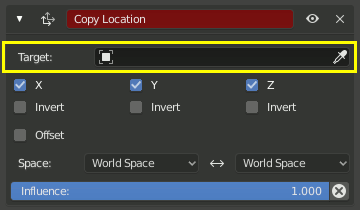
O campo Alvo deverá ser preenchido para que a restrição inicie seu funcionamento.¶
By default, the Target will use the Object Origin as the target point.
If the Target field links to a Mesh or Lattice object, a Vertex Group field will appear. Enter the name of a vertex group and the constraint will target the median point of this vertex group instead of the object’s origin.
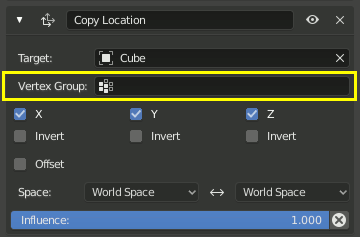
If the Target field links to an Armature, a Bone field will appear along with a Head/Tail slider. Enter the name of a bone and the constraint will target the bone instead of the entire armature object origin.
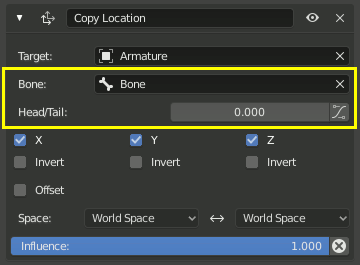
The slider moves the precise position of the target between the Head and Tail of the bone. Some constraints have a button next to the slider that enables using the curved shape of Bendy Bones.
Espaço¶
As restrições precisam de um enquadramento de referência de maneira a funcionar apropriadamente. Este enquadramento de referência é chamado de «espaço» da restrição. A escolha de um espaço versus outro irá alterar o enquadramento de referência e irá alterar substancialmente comportamento de uma restrição.
Para entender como a alteração do espaço de avaliação (enquadramento das referências) irá alterar o comportamento da restrição, considere a experimentação com dois objetos do tipo Vazio. Certifique-se de que eles estejam sendo mostrados como setas de maneira que você possa utilizar os eixos locais para cada um dos objetos do tipo Vazio. Também certifique-se de que a escala de um deles seja um pouco maior do que o outro de maneira que ambos sejam visíveis mesmo que estejam diretamente posicionados um sobre o outro. Então adicione uma restrição para um dos objetos tipo Vazio que tenha como alvo o outro objeto e faça diversas experimentações movimentando, escalonando ou rotacionando o alvo de diversas maneiras diferentes.
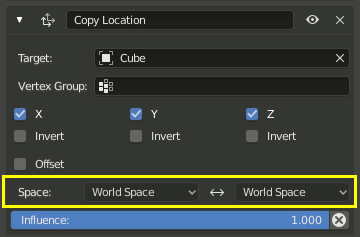
This constraint is set to use World Space as the frame of reference for both its Target space and its Owner space.¶
Espaço do alvo e espaço do proprietário¶
The space used to evaluate the target of the constraint is called the Target space. The space used to evaluate the constrained object (the object that owns the constraint) is called the Owner space. Hover over the space select menu(s) to learn whether it affects the space of the target or the space of the owner.
When the constraints use a Target and/or/nor an Owner space there will be no, one or two selector(s). The Copy Location constraint in example use both Target and Owner space.
When a constraint uses both Target and Owner space, the Target and Owner can be any combination of space types.
Tipos de espaço¶
- Espaço do ambiente
Neste tipo de espaço de avaliação, o ambiente é o enquadramento de referência para o objeto (ou osso). A sua localização é relativa a origem do ambiente. A rotação e escala estão orientadas aos eixos do ambiente. As transformações para o objeto, os parentes relacionados ao objeto e quaisquer outras restrições que estiverem em posições mais altas na pilha de restrições são todas levadas em consideração.
- Local Space
This space excludes all effects of the parent objects or bones, as well as the rest position and orientation of the bone itself. Only transformations applied to the object or bone itself are taken into account. It does include the effects of constraints though, for example the Child Of constraint or the Copy Transforms constraint.
Aviso
For objects without a parent Local Space has a special meaning, different from the normal behavior of local space for bones or objects that have a parent. This behavior is kept for backwards compatibility, but may be removed in the future and shouldn’t be used.
- Local with Parent Bones Only
The bone position and orientation is evaluated relative to its rest pose location and orientation, thus including both its own transformations and those caused by a possible parent relationship (i.e. the chain’s transformations above the bone).
- Pose Space Bones Only
The bone position and orientation is evaluated in the armature object local space (i.e. independently from the armature transformations in Object Mode). Hence, if the armature object has null transformations, Pose Space will have the same effect as World Space.
- Custom Space
The position and orientation is evaluated relative to the current position and orientation of an arbitrary object or bone that is specified via additional input fields that appear when this option is selected. This can be used to evaluate the constraint using an arbitrary coordinate system.
- Local Space (Owner Orientation) Bone Targets Only
This space works like Local Space, with an additional coordinate space transformation that compensates for the difference in the rest pose orientations of the owner and target bones. If applied as the Local Space of the owner, this will produce the same global space movement as the target, provided parents are still at rest pose.
This option replaces the following setup with two additional bones:
An extra child bone of the target, rotated the same as the owner in rest pose.
An extra sibling bone of the target, positioned same as the child in rest pose and using Copy Transforms in World Space from the child.
The constraint uses Local Space of the sibling instead of the original target.
This video demonstrates the difference from ordinary Local Space:
Influência¶
O deslizador de influência determina quanto a restrição irá afetar o objeto restringido (alvo).
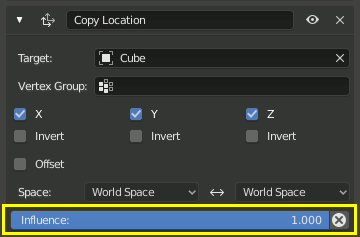
Uma influência de 0.0 não terá nenhum efeito. Uma influência de 1.0 terá o efeito pleno.
Values between (0.0 and 1.0) will have a partial effect, but be careful. These partial effects can be difficult to control, especially as the constraint stack grows in complexity.
O valor de influência é animável, permitindo que as restrições sejam desligadas, ou ligadas de maneira parcial conforme necessário.
- (Disable and Keep Transform)
Disables the constraint while trying to preserve the current object position. This may not work perfectly if other constraints remain active.